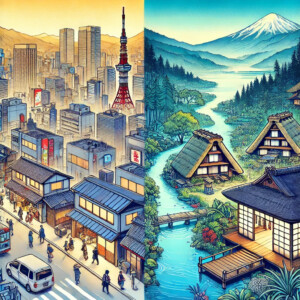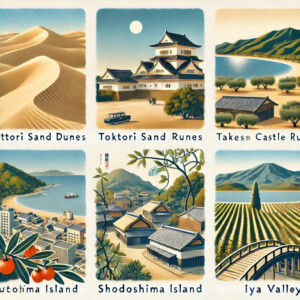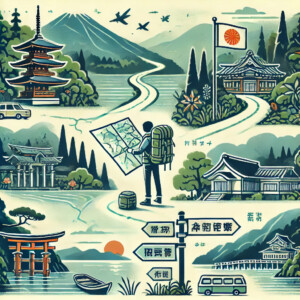1. Introduction
When most travelers think of Japan, the bustling streets of Tokyo, the historic temples of Kyoto, and the vibrant nightlife of Osaka often come to mind. These iconic destinations certainly deserve their reputation, but Japan is a country filled with lesser-known treasures that offer a deeper and more intimate cultural experience. For American travelers looking to go beyond the typical tourist spots, these hidden gems provide an opportunity to explore the heart of Japan in ways that few visitors ever do. This article aims to introduce you to some of Japan’s best-kept secrets—destinations that are off the beaten path yet brimming with beauty, history, and unique experiences.
2. Why Explore Beyond the Usual Tourist Spots?

Cultural Depth
Japan’s cultural richness is not confined to its major cities. In fact, some of the most profound cultural experiences can be found in its quieter, more remote regions. These hidden gems are places where time seems to have slowed down, where ancient traditions are still alive, and where the natural beauty of the landscape is unspoiled by modern development.
Authentic Experiences
One of the biggest advantages of venturing beyond the usual tourist spots is the opportunity to experience Japan more authentically. In these lesser-known areas, you’ll encounter fewer tourists, allowing for more meaningful interactions with locals. Whether it’s participating in a traditional festival, staying at a rural ryokan, or simply enjoying a meal at a family-run restaurant, these experiences offer a taste of Japan that is far removed from the commercialized tourism of the bigger cities.
Adventure and Discovery
For the adventurous traveler, exploring Japan’s hidden gems is an invitation to discover something new and unexpected. These destinations are not always easy to reach, but the journey is part of the adventure. Whether it’s navigating winding mountain roads, crossing vine bridges, or hiking through remote valleys, the sense of discovery and accomplishment you’ll feel upon arrival is unparalleled.
3. Spotlight on Hidden Gems

A. Tottori Sand Dunes (Tottori Prefecture)
Description: The Tottori Sand Dunes are one of Japan’s most unique landscapes—a vast stretch of sand that looks more like a desert than anything typically associated with Japan. Located in Tottori Prefecture along the coast of the Sea of Japan, these dunes span approximately 16 kilometers and are up to 2 kilometers wide, with some dunes reaching heights of 50 meters.
Cultural Experience: Despite its unusual appearance, the Tottori Sand Dunes are deeply connected to Japanese culture. Nearby, you can visit the Tottori Sand Museum, which showcases intricate sand sculptures created by artists from around the world. Each year, the museum features a new theme, with past themes including everything from the Great Wall of China to ancient Egypt. For the more adventurous, the dunes themselves offer activities like sandboarding and camel rides, providing a truly unique way to experience Japan’s natural beauty.
B. Takeda Castle Ruins (Hyogo Prefecture)
Description: Often referred to as Japan’s “Castle in the Sky,” the ruins of Takeda Castle in Hyogo Prefecture offer one of the most breathtaking views in the country. Perched atop a mountain at an elevation of 353 meters, the castle ruins are surrounded by a sea of clouds on certain mornings, giving the illusion that the castle is floating in the sky. Built in the 15th century, Takeda Castle was once a formidable fortress, but today only the stone walls and foundations remain.
Cultural Experience: The appeal of Takeda Castle goes beyond its stunning views. The ruins are a powerful reminder of Japan’s feudal past, and walking among the ancient stone walls provides a sense of connection to the samurai who once lived and fought here. The hike to the top is challenging but rewarding, with the surrounding landscape offering beautiful scenery throughout the year, from the cherry blossoms in spring to the vibrant autumn foliage.
C. Shodoshima Island (Kagawa Prefecture)
Description: Shodoshima Island, located in the Seto Inland Sea, is known for its Mediterranean-like climate and beautiful olive groves. The island was the first place in Japan to successfully cultivate olives, and today it is often referred to as “Olive Island.” Shodoshima is also famous for its scenic beauty, including the Kankakei Gorge, one of Japan’s most beautiful gorges, and the Angel Road, a sandbar that appears during low tide and allows visitors to walk between two islands.
Cultural Experience: Shodoshima offers a blend of traditional Japanese culture and Mediterranean influences. Visitors can explore olive farms, sample local olive oil, and even visit an olive-themed park. The island is also home to a number of soy sauce breweries, where you can learn about the traditional production methods that have been passed down for generations. Additionally, the island’s relaxed atmosphere and beautiful scenery make it a perfect retreat for those looking to escape the hustle and bustle of city life.
D. Ouchi-juku (Fukushima Prefecture)
Description: Ouchi-juku is a well-preserved post town located in Fukushima Prefecture, dating back to the Edo period (1603-1868). Once a bustling stop along the Aizu-Nishi Kaido trade route, Ouchi-juku is now a quiet village that has retained much of its historical charm. The town is characterized by its traditional thatched-roof houses, which line the main street and transport visitors back to a time when samurai and merchants traveled these roads.
Cultural Experience: Visiting Ouchi-juku is like stepping into a living museum. The town’s thatched-roof houses, many of which have been converted into shops, inns, and museums, offer a glimpse into the daily life of Edo-period Japan. One of the highlights of a visit to Ouchi-juku is the opportunity to try local specialties such as negi soba, a dish where the buckwheat noodles are eaten using a leek instead of chopsticks. The town also hosts traditional festivals throughout the year, where visitors can experience local customs and performances.
E. Iya Valley (Tokushima Prefecture)
Description: The Iya Valley, located in Tokushima Prefecture on the island of Shikoku, is one of Japan’s most remote and scenic regions. Known for its dramatic landscapes, the valley is characterized by steep mountains, deep gorges, and vine bridges that have been used for centuries. The valley’s remote location has helped preserve its natural beauty and traditional way of life, making it a perfect destination for those seeking an off-the-beaten-path adventure.
Cultural Experience: The Iya Valley is steeped in history and legend. The vine bridges, which were originally constructed by samurai fleeing the Heike clan in the 12th century, are a testament to the area’s rugged past. Crossing these bridges is an exhilarating experience, offering stunning views of the gorge below. The valley is also home to traditional thatched-roof houses, hot springs, and the famous Peeing Boy statue, a symbol of the valley’s wild and adventurous spirit. For those interested in outdoor activities, the Iya Valley offers opportunities for hiking, rafting, and exploring the untouched natural environment.
4. Tips for Traveling to Japan’s Hidden Gems

Getting There
Reaching these hidden gems often requires a bit more planning than visiting Japan’s major cities. However, the journey is part of the adventure. For destinations like the Tottori Sand Dunes and Takeda Castle, renting a car is recommended, as it allows for greater flexibility in exploring the surrounding areas. Shodoshima Island can be reached by ferry from Takamatsu, while Ouchi-juku is accessible by bus from Aizu-Wakamatsu Station. The Iya Valley, being one of the most remote, is best reached by car, although buses are available for those without a vehicle.
Cultural Etiquette
When visiting these lesser-known destinations, it’s important to respect local customs and traditions. This includes removing your shoes before entering homes or certain traditional buildings, being mindful of noise levels, and showing respect when visiting religious sites. In rural areas, locals may not be as accustomed to foreign visitors, so a friendly and polite attitude goes a long way.
When to Visit
The best time to visit these hidden gems depends on the destination. For example, the Takeda Castle Ruins are best visited in the early morning during autumn, when the sea of clouds is most likely to appear. The Tottori Sand Dunes are enjoyable year-round, but spring and autumn offer the most comfortable temperatures. Shodoshima Island is beautiful in spring when the olive trees are in bloom, while Ouchi-juku is particularly picturesque in winter when the town is covered in snow. The Iya Valley is stunning in autumn, when the foliage creates a vibrant tapestry of colors across the landscape.
5. Personal Stories or Testimonials

Traveler Testimonials
Travelers who have ventured to these hidden gems often describe their experiences as some of the most memorable of their trip to Japan. One traveler recalls their visit to the Tottori Sand Dunes as “like stepping into another world,” while another describes the thrill of crossing the vine bridges in the Iya Valley as “a heart-pounding adventure.” These testimonials emphasize the unique and rewarding experiences that await those who are willing to explore beyond the typical tourist routes.
Personal Insights
If you’ve had the opportunity to visit any of these destinations yourself, sharing your personal experiences can add a valuable perspective to the article. Describe how it felt to stand atop the Takeda Castle Ruins and watch the sunrise over a sea of clouds, or the serenity you experienced walking through the olive groves of Shodoshima Island. Personal anecdotes help create a connection with your readers and encourage them to consider these destinations for their own travels.
6. Conclusion
Exploring Japan’s hidden gems offers a unique opportunity to experience the country’s rich culture, history, and natural beauty in a way that goes beyond the typical tourist experience. These underrated destinations provide a deeper, more authentic connection to Japan, allowing travelers to discover a side of the country that is often overlooked. Whether you’re seeking adventure, tranquility, or a glimpse into Japan’s past, these hidden gems are sure to leave a lasting impression. So the next time you’re planning a trip to Japan, consider adding one of these destinations to your itinerary—you won’t be disappointed.
7. Recommended Itinerary (Optional)
For those interested in visiting multiple hidden gems in a single trip, here’s a sample itinerary:
Day 1-2: Arrive in Tottori Prefecture, explore the Tottori Sand Dunes, and visit the Sand Museum.
Day 3: Travel to Hyogo Prefecture and hike to the Takeda Castle Ruins. Stay overnight in a nearby ryokan.
Day 4-5: Take a ferry to Shodoshima Island. Spend two days exploring the olive groves, Kankakei Gorge, and local soy sauce breweries.
Day 6: Travel to Fukushima Prefecture and visit Ouchi-juku. Experience traditional Edo-period life and try negi soba.
Day 7-8: Head to Tokushima Prefecture and explore the Iya Valley. Cross the vine bridges, hike through the valley, and relax in a hot spring.
This itinerary allows travelers to experience a variety of Japan’s hidden gems, each offering a unique glimpse into the country’s diverse culture and landscapes.
4o
Comment